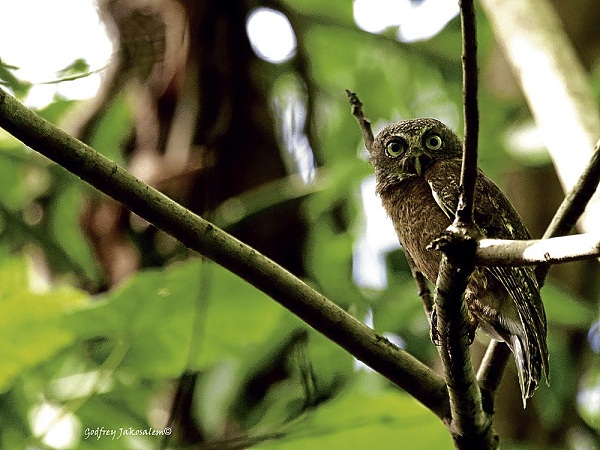Hawk owls rediscovered in Cebu forests

THE CEBU Hawk Owl has been named recently as a new full species of Philippine hawk owls. The bird is endemic to Cebu and cannot be found anywhere else in the world. Philip Godfrey Jakosalem/CONTRIBUTOR
IT was believed to be extinct because of massive deforestation in Cebu. But in 1998, bird ecologists rediscovered the existence of hawk owls in the small patches of forests in the town of Alcoy in the southern part of the island.
On Aug. 17, the Cebu Hawk Owl (Ninox rumseyi) was formally introduced to the world. It joins two other endemic bird species—the Cebu Flowerpecker (Dicaeum quadricolor) and the Cebu Black Shama (Copsychus cebuensis).
“The Cebu Hawk Owl might be critically endangered. The discovery tells us that we really have to go to the islands and implement separate conservation efforts because each island has its own endemism,” said Filipino bird ecologist Lisa Marie Paguntalan.
“Each island has its own provincial treasures which people should be proud of and take good care of,” she added.
Full species
The Cebu Hawk Owl is among the seven full species and one subspecies of hawk owls unveiled in an event co-organized by the Philippines Biodiversity Conservation Foundation Inc. (PBCFI) and the Philippine Business for Social Progress (PBSP). A similar announcement was simultaneously held in the United Kingdom and United States on Aug. 17.
Another new species, the Camiguin Hawk Owl, has been given its own scientific name, Ninox leventis.
“Knowing these owls would hopefully increase conservation efforts because each island has its own endemism that needs to be protected,” said Pamela Rasmussen, assistant professor at Michigan State University.
Rasmussen is the lead author of a taxonomy review of the Philippine hawk owls and co-author of the scientific initiative with a team of American, British and Filipino scientists—Desmond Allen, Nigel Collar, Bram Demeulemeester, Robert Hutchinson, Robert Kennedy, Frank Lambert, Lisa Marie Paguntalan and Philip Godfrey Jakosalem.
Paguntalan and Jakosalem are Filipinos working for the PBCFI, which is based in Bacolod City in Negros Occidental.
The latest discovery was published in “Forktail,” the Journal of Asian Ornithology.
Role
Owls play an important role in the food chain, Paguntalan said. They are predators and feed on smaller animals, such as rats, insects and snakes.
Before, the hawk owls were only treated under one classification. Now, the Philippine hawk owls have seven full species and one subspecies, Rasmussen said.
These include the Cebu Hawk Owl, Camiguin Hawk Owl, Luzon Hawk Owl (Ninox philippensis), Mindoro Hawk Owl (Ninox mindorensis), Romblon Hawk Owl (Ninox spilonota) with a subspecies found on Tablas Island (Ninox spilonota fisheri), Mindanao Hawk Owl (Ninox spilocephala) and Sulu Hawk Owl (Ninox reyi).
In the same event, the revision of the taxonomy of the Philippine Scops Owl led by Filipino ornithologist Hector Miranda was also announced.
Like the hawk owls, scops owls were also treated under one classification. The three former subspecies have been elevated to full species status—Luzon Lowland Scops Owl (Otus megalotis), Visayan Scops Owl (Otus nigrorum) and Mindanao Lowland Scops Owl (Otus everetti).
With this development, the Philippines now has a spectacular diversity of owls with 23 species and 12 subspecies, according to Philippine-based British taxonomist and mammalogist William Oliver.
Oliver, who cofounded the PBCFI in 1992, said 15 out of the 23 species are endemic to the country or can only be found in the Philippines. But with growing biodiversity comes a bigger challenge to conserve these birds.
“Many or most of these owls might be critically endangered or threatened and yet none of them is included in the international and national listings of threatened and protected species,” said Oliver, PBCFI director for program development and partnerships.
Rasmussen said the new subspecies of Ninox hawk owls in the Philippines were already known 15 years ago. But it was only last year when enough recordings were gathered to prove that these were not just subspecies but full species
“Going around, we found enough evidence that the Philippine hawk owl is not only composed of one species. They are separate species, each unique according to its island location,” she said.
She said the team studied and observed the measurements, appearance, behavior and vocalizations (calls) of the owls before publishing the taxonomy review.
Vocalizations are the owls’ unique way of communicating to their partners which are genetically programmed in their DNA. “Owls do not learn their songs,” Rasmussen said.
The introduction of the new owls was welcomed by the Department of Environment and Natural Resources (DENR).
“Scientific discoveries guide the government in implementing programs with the best impact,” said Nelson Devanadera, assistant director of the DENR’s Protected Areas and Wildlife Bureau.
Jakosalem, a Cebuano wildlife biologist and ornithologist who made an ecological study of the Cebu Hawk Owl, said the owls were found in the towns of Argao, Dalaguete, Alcoy and Boljoon.
Preference
“A pair of Cebu hawk owls covers a territory of 10 to
12 hectares. They prefer forests than plantations and there were no sightings of hawk owls in areas planted by mahogany and gmelina. It is important that we plant native and indigenous tree species, which are natural habitats of the owls,” he said.
Mahogany and gmelina are exotic tree species.
Paguntalan said people should know the right kind of trees to plant when doing reforestation work.
She said the PBSP, which implements reforestation efforts in the Central Cebu Protected Landscape (CCPL), was on the right track in contributing in biodiversity conservation and protection. The CCPL is Metro Cebu’s primary source of water.
To protect more endemic but endangered species, reforestation and conservation efforts could be expanded to other areas in Cebu, Paguntalan said.














